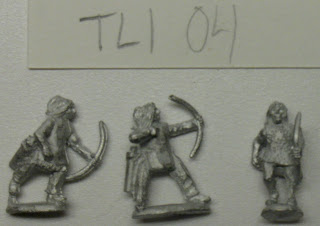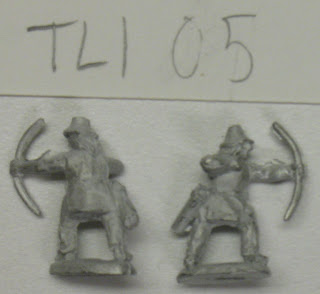







I ordered enough Eureka 15mm Tlingit figures to build DBA army IV/11: North-Western American. The elements are: 1x3Bw (Gen), 9x3Bw, 2x2Ps; and the army is Littoral, so sometimes it can drop some of the bow in the rear or flank of the enemy. Shooting entirely on the rear edge, anyone?
I am inspired to build this army mainly because my sister Sarah fled to Alaska after college and never looked back. Now, she’s living in Sitka, where the Battle of Sitka took place in 1804 between Tlingit warriors and Russian traders with the help of the Russian navy. That time period is well outside the scope of the DBA rule set, but the Tlingit lived in the area long before the Russians ever arrived.
These warriors were equipped in a very unique way, with wooden helmets in the form of animal heads, and wooden slat armor. I’d like to do a reasonable job painting them accurately, with the understanding that I’m not capable of reproducing much detail on masks that are only 3-4mm high.
The figures come in several different combinations of weapons and armor. I’m not sure if all of the sculpts are accurate or not, or if the DBA army list (primarily massed bowmen) represents the actual fighting style used by the Tlingit in the 12-14th centuries. Unfortunately, this selection of figures and army list definition are the only choice I have right now. If there are any major problems, I’m sure Slingshot, the publication of the Society of Ancients, would publish an article containing any better information that is available.
The main features I need to know how to color correctly are:
- I think the wooden slat armor is natural wood colored.
- The skin armor/clothing seems to either have the fur on the inside, or to be scraped clean; some have fur edges on the bottom. I don’t know whether these would be “natural” skin color, or whether they’d have designs painted on them.
- There are several wooden masks in animal forms, and an odd one (in the image TLI 03) that looks a bit like an upturned colander or medieval great helm. I understand these are typically painted in a light blue (turquoise? copper oxide?), black, and red (iron oxide?), but I’m not sure what patterns should be used (or whether I can pull them off in 15mm scale anyway). I’m also not sure if the hemet in TLI 03 is accurate or not.
- The conical wooden hats seem to be almost the correct shape compared to pictures I’ve seen, but I don’t know if they’d be worn in battle or what color they should be.
- What material would knives and spear points be made of, prior to European contact? Or would they be unavailable that early?
- I presume the sword-like implement is actually a wooden club?
- I’m not sure whether bows, clubs, and spear shafts would be plain wood, or painted. My initial inclination is to use my standard ochre yellow “wood-like color” for all of them.
So, Sarah: Please tell me if these pictures are any better than the ones already available on Eureka’s web site. I don’t have a great photo setup, and I tend to have problems with getting proper focus in macro mode. Unpainted miniatures, especially this small, are notoriously difficult to photograph well unless you give them a black wash to bring out the highlights.
The dime is here for scale comparison purposes, for those unfamiliar with the diminutive size of 15mm figures.
Thanks!
Edit: One more thing: how are an army’s leaders distinguished from its “rank and file” soldiers, so to speak? In DBA, the army’s “general” (or army-appropriate leader) must be visually different from other similar elements.
Sitka Charter School Committee says:
1. Yes the wooden armor is wood colored, often with clan symbols painted on it, but starting out with wood (cedar, specifically, I'm not sure if it's red or yellow cedar) will be on the right track.
2. Skin armor: probably scraped clean or fur on the inside. Also would have been natural or had clan symbols painted on it.
3. The upside-down colander hat would be made of woven cedar roots and would start wood-colored, but also could have dyed root designs woven into it. I've never seen anything like the one in TLI-03, but I'm no expert. The cedar hats were very common and would be used in battle and in everyday life.
4. Historically, the Tlingit traveled great distances to trade with other Native Americans (as far as California and all the way up to the arctic) so they had a lot of materials not available locally. Halibut hooks have been made of bone, so I imagine spears and knives would have also; also I know obsidian was used and is available locally. I think the club idea is likely, but again, I'm no expert.
5. I'd go with "wood" for the bows and spear shafts, too.
What you really need to do is come visit and do the research here at the state museum. The foremost expert on Tlingit armor in the world lives here and carves at the Southeast Alaska Indian Cultural Center and entertains tourists regularly. He went on a world tour to view battle armor in museums from Russia to France to Boston to DC last year. I'm Facebook friends with him so I"ll see if I can link to his galleries- if nothing else, I'm sure you could link through Marla. There's a book I've been meaning to buy down there for a while, too, so I could go down and see if I can find a book for you.